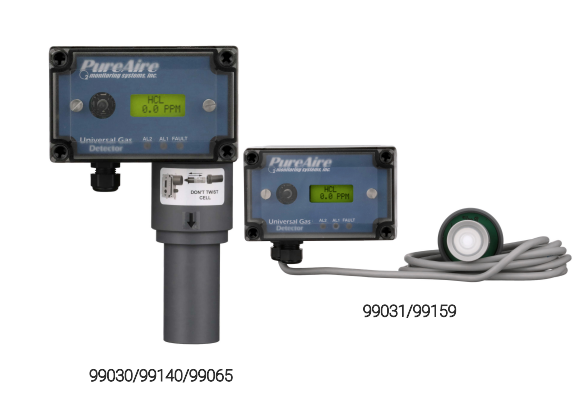What is a Fixed Gas Detector?
- By : PureAire Monitoring Systems
- Posted on : March 21, 2024
- News Room
The evolution of toxic gas detectors is rooted in industrial safety, with milestones marking significant leaps in detection technology. In the early 20th century, electrochemical sensors were among the first devices designed to identify lethal gases in coal mines. The sensors relied on a chemical reaction between the toxic gas and an electrode, generating an electrical signal proportional to the gas concentration.
By the 1960s, advancements in electrochemical sensors enhanced specificity and sensitivity while increasing the number of toxic gases and vapors that could be monitored. These developments meant industries could more effectively monitor environmental conditions, contributing to improved workplace safety standards.
The following decade ushered in another game-changing development: the introduction of infrared gas detectors. This technological leap provided a new approach to gas monitoring by measuring gases’ unique absorption spectra, offering a non-contact, more accurate, and reliable method for detecting gas concentrations.
Fixed gas detectors have become essential equipment in industrial safety systems. PureAire’s fixed gas detectors incorporate renewable toxic gas sensors, setting new benchmarks for durability and precision.
The evolution of gas sensors from early electrochemical solutions to today’s sophisticated systems exemplifies a commitment to protecting human life and maintaining operational integrity across various applications.
Importance of Gas Detectors in Different Industries and Applications
Toxic gas monitoring systems contribute to safe working environments in any scientific or industrial application utilizing toxic gases and, therefore, requiring continuous monitoring of toxic gas levels. For instance:
Semiconductor Manufacturing: The semiconductor industry presents a unique set of challenges regarding gas monitoring. Manufacturing processes in this industry often involve highly reactive gases like arsine, phosphine, silane, etc., which can be hazardous if not properly monitored. Advanced fixed gas detectors designed for semiconductor manufacturing often utilize renewable electrochemical sensor technology, which provides for accurate detection of a wide range of toxic gases and vapors. PureAire’s renewable sensors are examples of such advancements that have proven effective in semiconductor manufacturing processes. Their long-term stability, accuracy, and renewable nature make them an ideal choice for this industry. You can learn more about these advanced solutions here.
Refrigeration Systems: Ammonia is a common refrigerant used in commercial and industrial refrigeration systems, which include food processing, manufacturing, packaging, transportation, and storage. While it is an efficient and environmentally friendly refrigerant, ammonia leaks can be dangerous, posing risks of fire, explosion, and health hazards to workers. Continuous monitoring of ammonia levels is, therefore, essential in these settings. Toxic gas detectors equipped with electrochemical sensors provide reliable detection of ammonia leaks. PureAire’s gas detectors offer reliable ammonia detection capabilities with -25 to +122F (-32 to +50C) operating temperatures, ensuring safety in refrigeration facilities.
Petrochemical: The production and processing of petrochemicals involves working with flammable and toxic gases. Monitoring gas concentrations is vital to prevent accidents and protect personnel and facilities.
Welding: Welding operations release fumes and gases that can be harmful to welding personnel when exposed to them for extended periods. Gas detectors identify and minimize these risks for welders.
Toxic gas detectors are indispensable across multiple industries where the presence of toxic gases or vapors could compromise employee health and safety. Gases commonly used in welding are oxygen, carbon dioxide, helium, or fuel gases such as acetylene, propane, butane, etc.
Gas Sensors
There are four commonly used gas sensors: electrochemical, infrared, renewable electrochemical, and zirconium oxide sensors for gas detection.
- Electrochemical sensors: Fixed detectors often employ these sensors due to their stable and reliable operation, requiring less maintenance. They can detect a wide range of toxic gases by allowing them to diffuse through a porous membrane to an electrode where oxidation or reduction occurs.
- Infrared point sensors: These sensors use radiation passing through a known volume of gas, with energy absorbed at specific wavelengths proportional to the gas concentration.
- Renewable EC sensor: Renewable sensors regenerate their electrochemical elements, prolonging their lifespan while maintaining reliability. Toxic gas detectors, including PureAire’s line of toxic gas detectors, are built with renewable sensors, which offer long-term stability and accuracy. PureAire Renewable Sensors allow for continuous monitoring with consistent accuracy over time.
Understanding the nuanced differences between gas sensors is essential for selecting the appropriate gas detection system based on industry-specific needs and safety requirements.
What type of detector is used for gas?
Toxic gas detection systems are essential for maintaining workplace safety. Many industries use gas detectors across a wide variety of applications to detect and measure toxic gases. The detectors work by identifying toxic vapors and gases, including ammonia (NH3), hydrogen chloride (HCL), carbon monoxide (CO), lower explosive limit (LEL) indicators, oxygen (O2), sulfur dioxide (SO2), and hydrogen sulfide (H2S), among others.
Gas monitoring systems ensure the safety of employees by:
- Detecting Toxic Gases: Gas detectors identify trace amounts of toxic gases and vapors.
- Activating Alarms: The monitoring system immediately triggers visual and audible alarms when these toxic gases reach pre-defined thresholds.

- Warning Employees: The activated alarms promptly alert employees about potential exposure to hazardous conditions.
PureAire Monitoring Systems Toxic Gas Detectors
PureAire’s toxic gas detectors provide reliable gas monitoring to ensure employee safety in various industries. The PureAire Renewable Gas Sensor technology offers long-term stability and accuracy, making it an ideal choice for detecting toxic gases such as ammonia and HCL. Built with electrochemical sensors, PureAire gas detectors provide a comprehensive solution for toxic gas applications. An alarm is triggered when the detected gas levels exceed the predetermined safe limits, providing an early warning to evacuate or take corrective actions.


